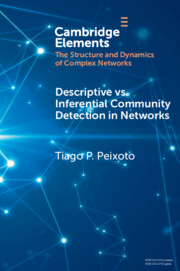Refine search
Actions for selected content:
48166 results in Computer Science

Descriptive vs. Inferential Community Detection in Networks
- Pitfalls, Myths and Half-Truths
-
- Published online:
- 04 July 2023
- Print publication:
- 31 August 2023
-
- Element
-
- You have access
- Open access
- HTML
- Export citation
Introduction to the 39th International Conference on Logic Programming Special Issue
-
- Journal:
- Theory and Practice of Logic Programming / Volume 23 / Issue 4 / July 2023
- Published online by Cambridge University Press:
- 04 July 2023, pp. 624-631
-
- Article
-
- You have access
- HTML
- Export citation
Understanding cirrus clouds using explainable machine learning
-
- Journal:
- Environmental Data Science / Volume 2 / 2023
- Published online by Cambridge University Press:
- 04 July 2023, e19
-
- Article
-
- You have access
- Open access
- HTML
- Export citation
Clustering of causal graphs to explore drivers of river discharge
-
- Journal:
- Environmental Data Science / Volume 2 / 2023
- Published online by Cambridge University Press:
- 04 July 2023, e25
-
- Article
-
- You have access
- Open access
- HTML
- Export citation
Neural style transfer between observed and simulated cloud images to improve the detection performance of tropical cyclone precursors
-
- Journal:
- Environmental Data Science / Volume 2 / 2023
- Published online by Cambridge University Press:
- 04 July 2023, e20
-
- Article
-
- You have access
- Open access
- HTML
- Export citation
A novel workflow for streamflow prediction in the presence of missing gauge observations
-
- Journal:
- Environmental Data Science / Volume 2 / 2023
- Published online by Cambridge University Press:
- 04 July 2023, e23
-
- Article
-
- You have access
- Open access
- HTML
- Export citation
Regression of binary network data with exchangeable latent errors
-
- Journal:
- Network Science / Volume 11 / Issue 3 / September 2023
- Published online by Cambridge University Press:
- 03 July 2023, pp. 502-535
-
- Article
-
- You have access
- Open access
- HTML
- Export citation
Editorial II: Meeting at the crossroads of Memory, Mind & Media
- Part of
-
- Journal:
- Memory, Mind & Media / Volume 2 / 2023
- Published online by Cambridge University Press:
- 03 July 2023, e3
-
- Article
-
- You have access
- Open access
- HTML
- Export citation
Pollution tracker: Finding industrial sources of aerosol emission in satellite imagery
-
- Journal:
- Environmental Data Science / Volume 2 / 2023
- Published online by Cambridge University Press:
- 03 July 2023, e21
-
- Article
-
- You have access
- Open access
- HTML
- Export citation
Identifying climate models based on their daily output using machine learning
-
- Journal:
- Environmental Data Science / Volume 2 / 2023
- Published online by Cambridge University Press:
- 03 July 2023, e22
-
- Article
-
- You have access
- Open access
- HTML
- Export citation
Debris: Machine learning, archive archaeology, digital audio waste
-
- Journal:
- Organised Sound / Volume 28 / Issue 3 / December 2023
- Published online by Cambridge University Press:
- 30 June 2023, pp. 392-406
- Print publication:
- December 2023
-
- Article
-
- You have access
- Open access
- HTML
- Export citation
RELEVANT CONSEQUENCE RELATIONS: AN INVITATION
- Part of
-
- Journal:
- The Review of Symbolic Logic / Volume 17 / Issue 3 / September 2024
- Published online by Cambridge University Press:
- 30 June 2023, pp. 762-792
- Print publication:
- September 2024
-
- Article
-
- You have access
- Open access
- HTML
- Export citation
Ensemble-based 4DVarNet uncertainty quantification for the reconstruction of sea surface height dynamics
-
- Journal:
- Environmental Data Science / Volume 2 / 2023
- Published online by Cambridge University Press:
- 30 June 2023, e18
-
- Article
-
- You have access
- Open access
- HTML
- Export citation
Exploration-exploitation-based trajectory tracking of mobile robots using Gaussian processes and model predictive control
-
- Article
-
- You have access
- Open access
- HTML
- Export citation
A precipitation downscaling method using a super-resolution deconvolution neural network with step orography
-
- Journal:
- Environmental Data Science / Volume 2 / 2023
- Published online by Cambridge University Press:
- 30 June 2023, e17
-
- Article
-
- You have access
- Open access
- HTML
- Export citation
Korean named entity recognition based on language-specific features
-
- Journal:
- Natural Language Engineering / Volume 30 / Issue 3 / May 2024
- Published online by Cambridge University Press:
- 29 June 2023, pp. 625-649
-
- Article
-
- You have access
- Open access
- HTML
- Export citation
10 - Proper Interpretation of Temporal Relators
- from Part II - Time and Events
-
- Book:
- Annotation-Based Semantics for Space and Time in Language
- Published online:
- 05 August 2023
- Print publication:
- 29 June 2023, pp 287-334
-
- Chapter
- Export citation
8 - Normalizing TimeML with Some Modifications
- from Part II - Time and Events
-
- Book:
- Annotation-Based Semantics for Space and Time in Language
- Published online:
- 05 August 2023
- Print publication:
- 29 June 2023, pp 208-234
-
- Chapter
- Export citation
6 - Annotation-Based Semantics
- from Part I - Fundamentals
-
- Book:
- Annotation-Based Semantics for Space and Time in Language
- Published online:
- 05 August 2023
- Print publication:
- 29 June 2023, pp 142-180
-
- Chapter
- Export citation
